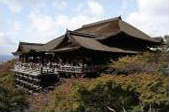 |
Kiyomizu-dera
This old temple was first built in 798, but the present buildings are reconstructions dating from 1633. The main hall has a huge veranda that is supported by hundreds of pillars and juts out over the hillside. Just below this hall is the water fall Otowa-no-taki, where visitors drink sacred waters believed to have therapeutic properties. The steep approach to the temple is known as Chawan-zaka (Teapot Lane) and is lined with shops selling Kyoto handicrafts, local snacks and souvenirs.
|